Читать книгу The Laura Lea Balanced Cookbook - Laura Lea - Страница 31
На сайте Литреса книга снята с продажи.
Оглавление2 Properly supply yourself with the basic kitchen
equipment and ingredient staples.
Much of the stress that people feel around
cooking comes from not having what they need
to make a dish. This leads to multiple grocery
runs, often last-minute, making the idea of a
pleasant kitchen experience seem impossible.
However, there’s an easy fix for this major
cooking roadblock: take the time and invest in
pantry and kitchen staples. I have purposefully
streamlined the tools and ingredients I use so
that I know I have the building blocks of my
dishes handy. The purpose of this guideline
is to create the same ease for you.
Cooking Equipment Staples
FOOD PREP BASIC EQUIPMENT
• Chef’s knife: This 8- to 10-inch knife with a
wide blade and pointed tip is a home cook’s
best friend, and it is worth springing for
a high-quality one if you can. I have several
knife sets, and I rarely use any knife besides
this and my paring knife. I like Orblue
and Wüsthof.
• Paring knife: This is a mini chef’s knife that
comes in handy when you need to peel or
chop more delicate and smaller fruits and
vegetables, such as garlic or strawberries. I
suggest the same brands as for the chef’s knife.
• Vegetable peeler
• Kitchen shears: I use kitchen shears to
trim fat off meat, snip herbs, and open
plastic packaging.
• Can opener
• Colander: I suggest two large stainless-steel
colanders, one with micro-perforations for
smaller grains, and one with slightly larger
holes for draining pasta or bigger vegetables.
• Salad spinner: This is almost an optional
piece, but it makes life so much easier, so
I highly recommend it. This dries delicate
lettuce leaves without damaging them,
ensuring you never have a soggy salad.
• Mesh strainer: I use this all the time for
draining and rinsing beans and grains.
• Pastry brush: This is the best way to spread
butter or oil evenly over ingredients for
roasting and grilling, or for greasing a dish
or baking sheet.
• Stainless-steel whisk
• Wooden cutting board: Use this for
vegetables and fruit.
• Plastic cutting board: Use this for meat;
bacteria can leach into wooden cutting
boards. However, be sure to replace your
plastic board if the cutting grooves become
too deep and hard to clean.
• Stainless-steel mixing bowl set
A vegetable
peeler and
paring knife
will make
short work
of prepping
smaller
vegetables.
